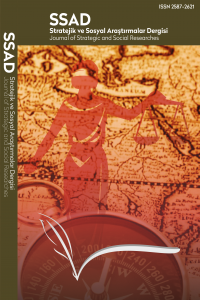KIRGIZİSTAN BURANA'DAKİ (BALASAGUN) KÜLTÜR VARLIKLARININ DURUMU
Özet: Burana (Balasagun), V- XI yüzyıllar arasında İpekyolu’nun önemli şehirlerinden biri olmuştur. Şehir X. yüzyılda, Karahanlıların hâkimiyetine geçtikten sonra, Orta Çağ Türk-İslam kent dokusuna uygun olarak yeniden inşa edilmiştir. Buna göre; etrafı surla tahkim edilmiş dış kale, şehristanda Cuma Camisi, pazar yerleri, mahalleleri ve mahalle camileri, medreseleri, türbeleri, hamamları, dükkânları, sivil konutları ile iç kaleden oluşan bir kent olduğu anlaşılmaktadır. Karahanlı dönemi Orta Çağ Türk-İslam şehir dokusunu yansıtan ilk örnek olması açısından Burana (Balasagun) şehri oldukça önemlidir.
Şehrin Cuma Camisi’nin minaresi olan Burana Minaresi, mahalle camisi olan Burana Cami ayrıca I, II ve III no.lu türbelerde XIX ve XX. yüzyılda sondaj çalışmaları yapılmıştır. Kısmı tamir de geçiren bu yapılar plan, süsleme ve İslami dönem kent dokusunu yansıtması açısından öncü yapılardır.
1976 yılında Kırgız Hükümeti tarafından Burana (Balasagun) şehri ören yeri olarak devlet korumasına alınmış, burası Açık Hava Müzesi özelliği kazanmıştır. Başta şehirdeki eserler olmak üzere çevredeki müzelik eserler burada sergilenmektedir. Eserler arasında; Burana Minaresi (Cuma Camisi’nin minaresi), Burana (Mahalle) Camisi ayrıca I, II ve III no.lu türbeler, petroglifler, balballar ile İslami dönem mezar taşları yer almaktadır.
Bu makalede ilk Türk-İslam devleti olan Karahanlıların başkenti Burana (Balasagun) şehri ve içindeki eserler kent dokusu bağlamında ele alınmıştır.
Situation of Cultural Properties in Burana (Balasagyn) Kyrgyzstan
Abstract: Burana (Balasagun) had been one of the important cities on the Silk Road between the 5th and 11th centuries. The city was rebuilt in the 10th century, after the domination of the Karakhanids, in accordance with the medieval Turkish-Islamic urban fabric. It is understood that the city consisted of an outer castle, fortified with a wall, a Friday Mosque, marketplaces, neighborhoods and mosques, madrasahs, tombs, baths, shops, civil residences, and an inner castle. The city of Burana (Balasagun) is very valuable in terms of being the first example reflecting the medieval Turkish-Islamic urban texture of the Karakhanid era.
Drillings were carried out in the 19th and 20th centuries in the Burana Tower, which is the minaret of the Friday Mosque, the Burana Mosque, which is the neighborhood mosque, and the mausoleums I, II, and III. These buildings, which were also partially repaired, are pioneering structures in terms of the plan, decoration, and reflecting the urban texture of the Islamic period.
The city of Burana (Balasagun) was put under protection by the Kyrgyz Government as an archaeological site in 1976, and the site gained the feature of an Open-Air Museum. Ancient artifacts in the surrounding area, especially those from the city, are exhibited there. Among the artifacts are the Burana Tower (the minaret of the Friday Mosque), the Burana Mosque (the neighborhood mosque) as well as the mausoleums I, II, and III, petroglyphs, balbals, and Islamic period tombstones.
In this article, the city of Burana (Balasagun), the capital of the Karakhanids (the first Turkish-Islamic state), and the artifacts of the city are discussed in the context of the urban texture.
Keywords:
Karahanlı, Burana, Kent Dokusu,
___
- Demir, N. (2009). Esatlı Köyü (Ordu-Mesudiye) Kaya Üstü Resim ve Yazıtları İle Bunların Tarihi Alt Yapısı. Zeitschrift für die Welt der Türken, (1/ 2), 3-30.
- Esin, E. (2002). Orduğ (Başlangıçtan Selçuklular Kadar Türk Hakan Şehri). Türkler, (3), 135-215.
- ISSN: 2587-2621
- Yayın Aralığı: Yılda 3 Sayı
- Başlangıç: 2017
- Yayıncı: Mehmet Ali KARAMAN
Sayıdaki Diğer Makaleler
OSMANLI DEVLETİ TIMAR SİSTEMİNDE İNTİKÂL MESELESİ: SİVAS SANCAĞI ÖRNEĞİ (1573-1651)
HİNDİSTAN UZAY PROGRAMININ KURULUŞ DÖNEMİ POLİTİKALARI VE KISA TARİHÇESİ
METAVERSE’DE BİREYİN TOPLUMSALLAŞMA SÜRECİ
Gül Dilek TÜRK, Abdülhakim Bahadır DARI
AVRUPA YEŞİL MUTABAKATI: YEŞİL TEORİ PERSPEKTİFİNDEN BİR ANALİZ
SAKARYA MEYDAN MUHAREBESİ’NDE 1. SÜVARİ TÜMENİ HAREKATI
1915 Çanakkale Köprüsü’nün Biga ve Bandırma’ya Yönelik Sektörel Etkileri
Betül OKUDUR SABUNCU, Gaye ATİLLA
